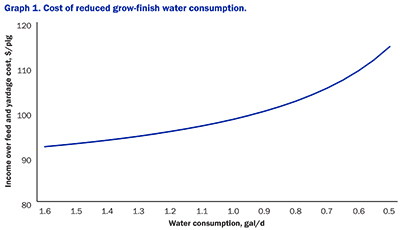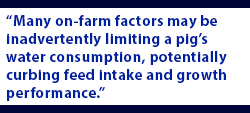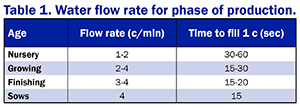
Water as a nutrient (part 1): Water intake fuels pig growth
 Editor’s note: This is the first article in a series about water and its impact on swine health and performance. Click here for part 2 on water quality and click here for part 3 on cleaning water lines.
Editor’s note: This is the first article in a series about water and its impact on swine health and performance. Click here for part 2 on water quality and click here for part 3 on cleaning water lines.
By Dr. Michaela Trudeau
There are direct, correlated relationships between water intake, feed intake, and bodyweight in nursery and grow-finish pigs. The estimated water:feed intake ratio in pigs is 2.5:1, but this can vary based on the animals’ age, type of diet, health status, environmental conditions, and water quality. Water is a critical nutrient for metabolic functions, nutrient delivery and regulation of body temperature. To ensure normal physiological processes can occur, enough water must be available to the pig. To maintain high feed efficiency, water availability becomes even more critical as the pig grows and feed intake increases.
Graph 1 summarizes how restricted water consumption in growing pigs can be related to added production costs (adapted from Brumm, 2000). Furthermore, a study done by Prairie Swine Centre (2014) found that adding an additional bowl waterer to a pen of 19 to 23 pigs that already had access to two separate wet-dry feeders increased the total carcass revenue per square foot of pen space by $4.23.

Changing water intake requirements
The exact water requirement per pig is highly variable and still being investigated. However, many known parameters will influence the pig’s water requirement.
- Temperature: In warmer summer temperatures, pigs will drink more water to help cool off and account for increased respiratory losses. Barn temperatures increasing from 54-60 degrees F to 86-95 degrees F will increase water consumption by at least 50%, so it may be necessary to add extra waterers during hot summer months.
- Diet: Fiber has a high water-holding capacity, which will make some of the water consumed by the animal unavailable for biological functions. In addition, excess protein in the diet will increase the water requirement, as water is necessary to remove byproducts of protein metabolism. For this reason, animals fed high-fiber diets or diets with excess protein should have additional water sources available to meet these requirements.
- Health: Young pigs experiencing diarrhea will have a dramatically increased water requirement and it is essential to provide these pigs with clean and adequate sources of water. Providing electrolytes is also a useful step to support pigs during enteric challenges.
 Encouraging water consumption
Encouraging water consumption
Despite limited research on exact water requirements, the consensus remains that pigs do not always consume enough water for maximum growth performance. Taking this into account, many on-farm factors may be inadvertently limiting a pig’s water consumption, potentially curbing feed intake and growth performance.
- Number of waterers: Pigs follow a drinking pattern where peak water consumption occurs between 3 and 9 p.m., meaning enough waterers need to be available for all pigs to drink during this high-demand time. If the number of waterers is limited, submissive animals may not get enough time at the waterer. The current recommendations is one waterer for every 10 to 15 pigs, depending on the age of the pig and type of waterer.
- Placement of waterer: Waterers should be 12 inches apart for nursey pigs, 18 inches apart for growing pigs, and 24 to 36 inches apart for finishing pigs and sows. Allowing space at the waterers will prevent aggression while pigs drink. Water placement should also consider lying and dunging behaviors. For example, pigs prefer to urinate in areas around drinkers, so, when possible, drinkers should be situated over slatted flooring.
- Height of waterer: For ideal water consumption with minimal water waste, nipple drinkers need to be adjusted to the shoulder height of the pig in the pen. When nipple drinker heights are not adjusted, pigs will use their nose to operate the nipple waterer and can waste up to 39% of water, increasing barn manure output.
 Flow rate: Pigs will only spend about 10 minutes per day drinking, so it is important to have an adequate flow rate to provide enough water during that time. Table 1 outlines the appropriate flow rate for each phase of production. An easy way to check flow rate is to time how long it takes to fill an 1-cup measuring cup.
Flow rate: Pigs will only spend about 10 minutes per day drinking, so it is important to have an adequate flow rate to provide enough water during that time. Table 1 outlines the appropriate flow rate for each phase of production. An easy way to check flow rate is to time how long it takes to fill an 1-cup measuring cup.- Type of waterer: Water intake remains consistent with different types of waterers, such as nipple or bowl waterers. Type of waterer does not seem to affect drinking behavior, but animals tend to spend more time at the waterer when using nipple waterers. Even though bowl waters provide more protection from accidental triggering, a well-managed nipple waterer produces the same amount of water waste as a bowl waterer.
- Water temperature: Pigs prefer cool water, especially in warmer temperatures. Daily flushing of waterlines will ensure fresh, cool water is available for consumption.
Contact your Vita Plus nutritionist if you have questions about the water requirements for animals in your barn or how to increase water intake.
Editor’s note: This is the first article in a series about the impact of water on pig health and performance.
About the author: Dr. Michaela Trudeau joined Vita Plus as a swine nutritionist in 2020. She grew up in Minnesota and attended the University of Minnesota to receive her bachelor’s degree in animal science with honors. Trudeau continued her education at the University of Minnesota and received a master’s degree in animal science. Her master’s thesis focused on the persistence of porcine coronaviruses in feed and feed ingredients. In December 2020, Trudeau received her Ph.D. in animal science at the University of Minnesota, where her research focused on understanding the mechanisms of growth responses to various antibiotic alternatives in nursery pigs.
| Category: |
Animal health Feed quality and nutrition Swine Performance |

